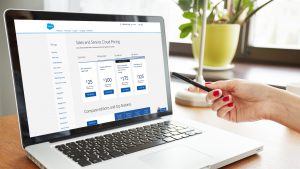We’ve barely shaken the sand off our feet and Salesforce is already preparing us for winter. Since last August 16, the notes associated with the Winter ’24 Release have been available as a first approach to the new features and improvements that this season brings us. You have also had the opportunity to try them because the pre-release organizations have been accessible since August 21 and the sandboxes have been updated since August 25.
Remember that you can access the Release module Trailhead Highlights where you’ll find demos and community forums to help you prepare to make the most of these new features. You should also not miss the new trailmixes available on the #LearnMOAR page .
After experimenting with the new features of this Winter ’24, as usual we share with Salesforce admins some of the functionalities that we consider most relevant. This time we were very pleased to see how several of these features have been promoted by members of the Salesforce community. Thanks to the IdeaExchange platform, this great community and the company were able to integrate and make Salesforce better for everyone.
Please note that this article is not a detailed guide to all features. If you want to go deeper you can consult the Winter ’24 Release Notes.
Relevant aspects of the general features of Salesforce
MFA Auto-Enablement Continues and MFA Enforcement Begins with Summer ’24
As of February 1, 2022, it is a requirement for Salesforce to use multi-factor authentication (MFA) to access its products, either through direct logins with a username and password or through login unique (SSO). To encourage compliance with this requirement, Salesforce has automatically enabled and enforced MFA since Spring ’23. Administrators still have the ability to disable this option if users are not ready and possibility will exist until Spring ’24. We recommend that you prepare your users as soon as possible to use MFA because by Summer ’24 it will be mandatory across all products. Salesforce will always keep you updated on the topic, via email or notes depending on the product you use.
Set a Password or Expiration Date on a Public Link to a Salesforce File
Although this new functionality is more user-oriented, it is good for administrators to know and replicate due to its positive impact on information protection and it allows you to apply different security measures to files that are shared. By default, when creating a public link to share a file, it has the option to expire after 30 days enabled. Now this date can be modified and you can enable the option to add an automatically generated password. These options only apply to files, not shared folders.
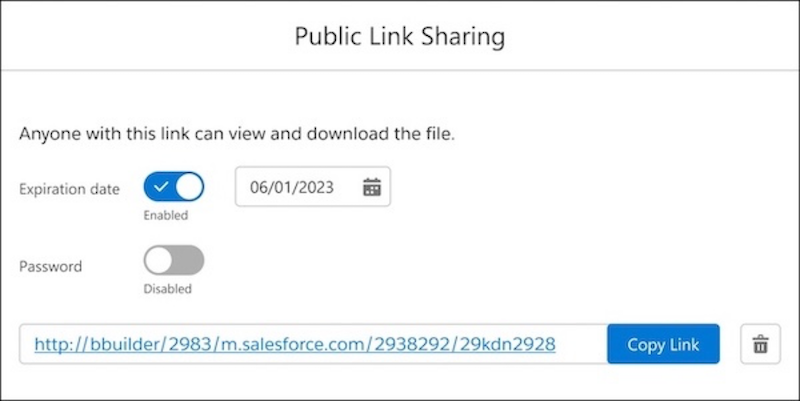
Lightning Reports and dashboards
Transfer Ownership of Lightning Dashboards (Beta)
This new functionality significantly facilitates access control over the dashboards. To use it, you must have the View all data or View my team’s dashboard permission. You must also have access to edit or manage the folder that contains the dashboard.
Thanks to the Change Owner option, with just one click you can transfer ownership of a Lightning dashboard from one user to another. If a dashboard creator changes responsibilities within the company or leaves the organization, you can easily assign full control over the dashboard’s content to someone else. The new owner will also have editing permission on the dashboard folder. Previously, you had to clone or recreate the dashboard.
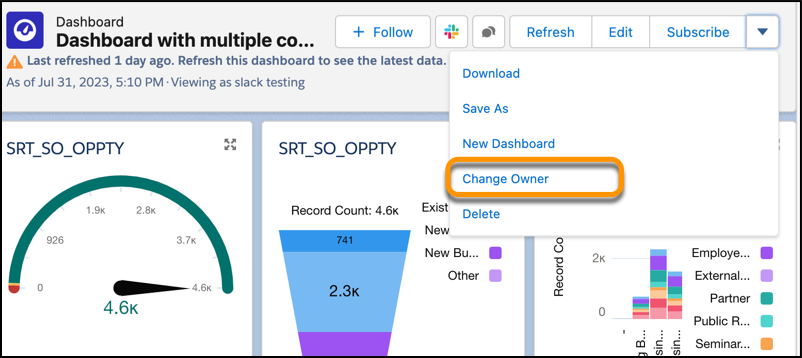
Visualize Lightning Reports with Summary Formulas as You Create Them
Currently there are very few functionalities left in Salesforce Classic that you cannot find in Lightning Experience. With this release comes the possibility of instantly viewing in your Lightning reports how the summary formulas that include the PARENTGROUPVAL or PREVGROUPVAL functions are applied.
Highlights in customizations
Permissions
IdeaExchange Delivered: Report on Custom Permission Set and Permission Set Group Assignments
As we mentioned previously, this is one of those features that have arisen at the request of the Salesforce community. Now you can create custom reports that allow you to briefly view the users who have been assigned to a permission set or group of custom permission sets.
See API Names for Object and Field Permissions in Permission Sets
It will allow you to more easily identify the permissions of objects and fields in permission sets, when you have multiple components with the same name. Now in addition to the object and field label, the Object API Name and Field API Name are also displayed.
See How Many Permission Set Groups a Permission Set Is Added To
Now when you are managing permission sets you will be able to measure the impact that the changes you make to them may have. This new property lets you know the number of permission set groups that a given permission set has.
Lightning App Builder
IdeaExchange Delivered: Use Dynamic Forms on LWC-Enabled Standard Objects
Previously, dynamic forms could only be used on custom objects and some standard objects. From now on, dynamic forms will be supported with most LWC (Lightning Web Component) capable objects. You’ll get an improved management experience and the option to apply visibility rules on objects so users can only see what they need, when they need it.
IdeaExchange Delivered: Give Your Mobile Users the Dynamic Forms Experience (Generally Available)
Broadly speaking, this allows you to increase customization options in the implementation of your Lightning record pages. You will be able to guarantee mobile users the same user experience that desktop users have. You can now add and remove fields individually from a Lightning record page. You’ll also be able to split record details into multiple sections and set conditional visibility rules for fields and field sections. All this will be possible from the Lightning App Builder .

Sharing
Once again, reports become your allies when it comes to managing user access. You can now create custom reports in the Account Share object to view which account records are shared manually or through account teams and which users or groups have access to them.
View Public Group Members with Reports
Now you can create custom reports where you can view: users, functions and groups that became part of public groups. This functionality significantly facilitates the management of user affiliations to public groups, since until now you could only obtain this information by clicking on each public group or executing queries that were returned by its members.
General configuration
IdeaExchange Delivered: Save Time with Mass Quick Actions on Related Lists (Generally Available)
In this version the supported quick actions are: Create a record and Update a record. Quick actions can be configured with predefined field values and action formats that include only the most important fields. By adding these quick actions to related lists, users will be able to create records related to items in the list without leaving the page. In addition, they will be able to perform mass updates on up to 100 related records at a time. As shown in the image:
- New and Update Contacts are the added quick actions. Update Contacts is the selected quick action.
- The contacts selected to apply the action to.
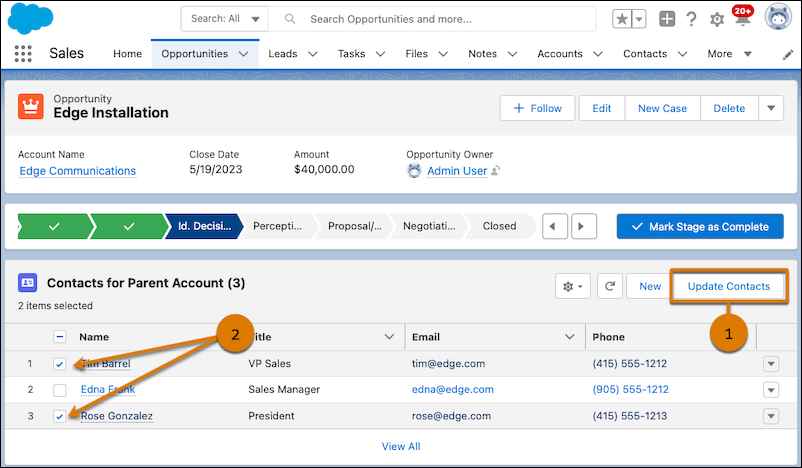
Important updates to Flow Builder
IdeaExchange Delivered: Create Custom Error Messages in Record-Triggered Flows
Previously, when an error occurred during the execution of a flow, the change to the associated record was reverted and the user did not receive any information about what had happened. Now, with this new option, you will be able to provide end users with an explanation of what the problem was and how to correct it. Error messages are displayed in a window on the general log page or as an inline error for a specific field.
Send Salesforce Data to an External Server Without Code via HTTP Callout (Generally Available)
From now on in Flow Builder if you need to send Salesforce data to an external server, and you cannot use the GET method with an HTTP call, you have the alternative of using the POST method. This functionality includes some modifications since the Beta version, in the Summer ’23 Release.
With this update you will be able to count on the PUT, PATCH and DELETE methods during integration with external data. You’ll also be able to provide more context about HTTP call parameters, validate JSON samples more quickly, and get information about external service registration with better organization in parameter sections.
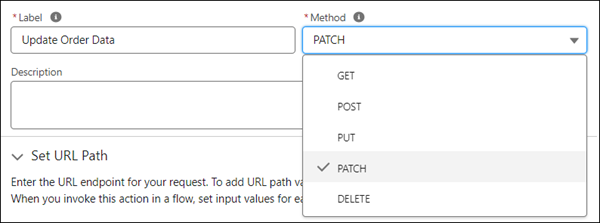
Transform Your Data in Flows (Beta)
Now with the new Transform element added to Flow Builder, in combination with the Action element, you will be able to create flows that integrate data external to Salesforce without having to enter code. You can use this new capability when transforming data into screen flows, automatically started flows without triggers, and flows triggered by records.
Save a Flow Without Configuring Some Elements
This is a very convenient update that allows you more flexibility when creating your flows. Errors that previously prevented you from saving the flow without finishing configuring startup items, are now displayed as warning messages. This new functionality can be used in flows triggered by records and in the Create Records elements in all flows. Thanks to this new option, Flow Builder is getting closer and closer to the ability to save a draft flow at any point in the creation process.
To be able to do this, the element properties window was also updated. Some properties now slide open next to the flow in the workspace, allowing you to view and interact with the flow while configuring elements.
Previously, item properties windows would block the flow view while open. Additionally, the cancel button feature in the item properties window has been replaced with the ability to undo changes one at a time with the new undo option.
Refresh Values Between Screens for More Components
You will now be able to navigate between component properties screens and reflect changes to the values you have updated. This applies to Date, Date & Time, Number, Currency, Text, and Long Text Area. Example: If a user enters the cost of three services on the first screen, when the user navigates to the next screen, the screen flow displays the total cost. If the user returns to the first screen and changes a value, they can update the total cost on the next screen or leave it unchanged.
You must enable this option in the component properties panel, under Advanced.
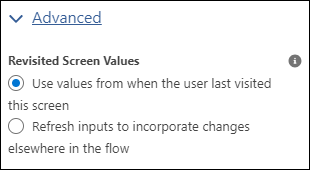
Advanced Pause Element Is Now Named Wait for Conditions
The functionality of the element remains the same. The name was only changed so that all waiting elements had similar terminology.
Use Filters to Find Record-Triggered Flows Quickly
Now in the Flow Trigger Explorer, you can filter results by status, package status, or process type.
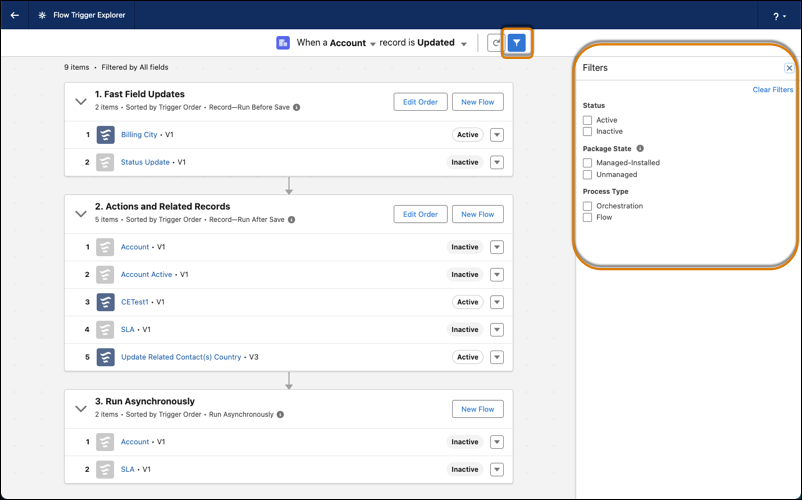
Version updates
The Version Updates page provides a list of updates whose activation may impact your organization. You can access them from Settings, in the Quick Find box and enter Version Updates.
These updates comply with an application schedule in future versions. During that period, updates may be tested, postponed or canceled. These are some of the updates that will be applied to your organization this Winter ’24.
Deploy Enhanced Domains (Release Update)
Enhanced domains must be implemented to comply with the latest browser and security standards. This option allows your users to access Salesforce from browsers that block third-party cookies. Consistent domain formats improve the user experience and standardize URLs for use in custom code and API calls.
This update impacts app and login URLs, including Experience Cloud Sites, Salesforce Sites, and Visualforce Pages. Your company’s specific My Domain name will be included in the URLs that Salesforce hosts for your organization.
Ideally, you should implement the enhanced domains in your organization before it is enforced this Winter ’24.
Make Paused Flow Interviews Resume in the Same Context (Release Update)
When this update is activated, if the flows that start automatically are stopped, they can be resumed in the same context in which they were paused. Additionally, for each flow running on API version 57.0 or later, the user’s permission to run the flow is verified before an interview resumes.
In the event that you had Process Builder processes that start flows containing Pause elements, Salesforce recommends configuring these flows to run on API version 57.0 or later. Otherwise, this update may change the context of resumed interviews. Process-launched Flows would resume in the context specified in the version properties of the flow.
Flow and process version updates
Flow and Process Run-Time Changes in API Version 59.0
In the notes you can find several updates that affect flows and processes configured to run on API version 59.0 or later, but we want you to pay particular attention to this one because of the security and flow access impact it represents:
Restrict user access to run all flows
When this update goes into effect, it disables the FlowSites license and flows will run more securely. Users will only be able to run flows to which they have permission.
Don’t miss the opportunity to take full advantage of the features that Salesforce offers in each release, make sure to test them with plenty of time ahead of its launch. If you found our selection interesting and want to know about the services we offer, do not hesitate to contact us at hello@theskyplanner.com, we will be happy to assist you.
